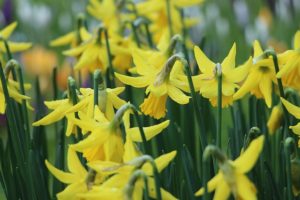The daffodils are awakening and filling our gardens and countryside with splashes of yellow. A most welcoming sign that Spring is soon to be with us – the days are getting longer and there is more time get things done outdoors. 
All garden ponds require regular maintenance to keep them looking good. Deep ponds do tend to remain cleaner than shallow ones. Algae, particularly blanket weed tends to occur in newer ponds where a balanced ecosystem has not yet been established or in one which is overstocked with fish. The best way to deal with algae is to remove it on a regular basis using a plastic rake to remove the filamentous weed. Barley straw is an environmentally friendly treatment for blanket weed. Submerge mesh bags of barley straw just below the water’s surface in early spring (replace the straw when it turns black). Chemicals released when the straw decomposes inhibits the growth of algae.
Garden pond spring checklist
While we still have a few weeks to go before it is officially Spring, it’s important to schedule in a pond care checklist for when the days do start to get warmer. Spring will also become evident when fish start swimming around more energetically and plants are poking green shoots above the water. Koi fish should not be fed until the pond water temperature is stable at around 55 degrees F (12 degrees C).
Things to do in spring:
- Give your pond filter a good cleaning. If you have a bio-filter, give it a boost of a bacteria/enzyme product to ensure a good bacteria colony starts to grow in the bio-filter.
- Clean your pond pump and check all hoses for leaks or cracks.
- If you have a net covering your pond, make sure it is still intact, if not, replace it.
- Remove leaves or other debris in your pond – as the water warms up, any debris left in your pond will start to decompose and affect the health of fish.
- Check your fish for any illnesses or wounds.
- Divide and repot pond plants. Avoid re-potting with soil full of organic matter. Most water plants grow well in sand and don’t require fertilizer. Water lilies are, however, an exception and do require fertilizer for a healthy growth. Water plants get their nutrients from fish waste. If you have extra plants after you have divided them, you may want to consider growing them in low, damp spaces in your garden.
- For fish ponds, make sure that up to half of the surface of your pond is covered with floating plants as it gives the fish a place to hide from predators and keeps them cool in the heat of the summer. It also keeps the sun from encouraging algae growth.
- If your pond is lined with a pond liner check that the material you have used for the edging is still in place, sufficiently covering the pond line to prevent any possible damage from claws or the UV rays – rubber pond liners are UV stable and will withstand long periods of UV exposure – but, a bare edging exposing a pond liner can detract from the beauty of the pond.
Spring marks a time when ponds come back to life after the winter lull. Frogs will start visiting garden ponds to spawn. Gold fish start to awaken and the males start to feel frisky chasing the females around the pond. Insects start to hatch. Herons will be getting ready to nest and on the look out for an easy meal of goldfish or koi – look out for them in the early hours of the morning. Spring is also a time for growth, so look out for your aquatic plants and make sure they don’t start occupying all of your pond.
HAPPY SPRING CLEANING – when the good weather arrives!!





